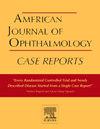Third nerve palsy as first presenting symptom of Guillain-Barre Syndrome spectrum clinical variant
Q3 Medicine
引用次数: 0
Abstract
Purpose
To report an unusual presentation of a Guillain-Barre Syndrome (GBS) spectrum clinical variant with an initial isolated, unilateral third nerve palsy prior to development of areflexia and lower extremity weakness.
Observations
A 16-month-old presented with a pupil-involving right third nerve palsy and normal lower extremity strength and reflexes. She was treated with a short oral steroid taper for presumed post-infectious cranial nerve (CN) palsy and had initial improvement. Soon after completing the taper, she developed an inability to sit, stand, or crawl with lower extremity areflexia. Magnetic resonance imaging of the spine showed diffusely thickened and enhancing cauda equina nerve roots and lumbar puncture showed isolated elevated protein, consistent with a diagnosis of a GBS spectrum disorder. She was treated with intravenous immunoglobulin and had complete resolution of ptosis as well as normal extraocular movements.
Conclusions and importance
Pediatric cases of acute third nerve palsy are most often traumatic, neoplastic, vascular, or demyelinating. These cases are less likely to have a post-viral etiology in contrast to the more commonly encountered acquired sixth nerve palsy. An isolated, unilateral third nerve palsy is a rare presentation of GBS and its clinical variant Miller Fisher Syndrome. This case demonstrates the importance of a high level of suspicion, particularly in the context of worsening systemic symptoms, to include these demyelinating disorders as a possible cause of unilateral CN palsy, as they can have a good prognosis if treated appropriately.
第三神经麻痹为格林-巴利综合征谱系临床变异的首发症状
目的报告一个不寻常的格林-巴利综合征(GBS)谱临床变异,在发展为反射性松弛和下肢无力之前,最初是孤立的,单侧第三神经麻痹。观察:16个月大的患者表现为累及瞳孔的右侧第三神经麻痹,下肢力量和反射正常。她被认为是感染后脑神经(CN)麻痹,接受了短期口服类固醇治疗,并有初步改善。完成渐缩治疗后不久,患者出现下肢反射症,无法坐下、站立或爬行。脊柱磁共振成像显示弥漫性马尾神经根增厚和增强,腰椎穿刺显示孤立的蛋白升高,与GBS谱系障碍的诊断一致。经静脉注射免疫球蛋白治疗,上睑下垂完全消退,眼外运动正常。结论及重要性:小儿急性第三神经麻痹多为外伤性、肿瘤性、血管性或脱髓鞘性。与更常见的获得性第六神经麻痹相比,这些病例不太可能有病毒后病因。孤立的单侧第三神经麻痹是GBS及其临床变体Miller Fisher综合征的罕见表现。该病例表明高度怀疑的重要性,特别是在全身性症状恶化的情况下,将这些脱髓鞘疾病作为单侧CN性麻痹的可能原因,因为如果治疗得当,它们可以有良好的预后。
本文章由计算机程序翻译,如有差异,请以英文原文为准。
求助全文
约1分钟内获得全文
求助全文
来源期刊

American Journal of Ophthalmology Case Reports
Medicine-Ophthalmology
CiteScore
2.40
自引率
0.00%
发文量
513
审稿时长
16 weeks
期刊介绍:
The American Journal of Ophthalmology Case Reports is a peer-reviewed, scientific publication that welcomes the submission of original, previously unpublished case report manuscripts directed to ophthalmologists and visual science specialists. The cases shall be challenging and stimulating but shall also be presented in an educational format to engage the readers as if they are working alongside with the caring clinician scientists to manage the patients. Submissions shall be clear, concise, and well-documented reports. Brief reports and case series submissions on specific themes are also very welcome.
 求助内容:
求助内容: 应助结果提醒方式:
应助结果提醒方式:


